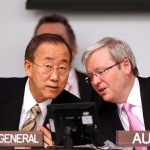Spanky Banky’s Employment Tribunal
On The Case By Jeffrey Phillips
 |
1. In the ABC Insiders’ compere Barry Cassidy’s new book called, “Party Thieves” (Melbourne University Press), former Prime Minister Kevin Rudd is said to have referred to the United Nations Secretary-General Ban Ki-Moon as “Spanky Banky”. However, New South Wales Supreme Court Justice Michael Adams, in a series of decisions , whilst on secondment to the United Nations’ internal employee tribunal , the United Nations Dispute Tribunal( UNDT) has given some UN officials a thorough spanking. (See Betucci ats Secretary-General of the United Nations Judgment Order No. 59(NY/2010)/Rev.1). Justice Adams who a few years ago, delivered a leading case on gross workplace bullying (Naidu ats Group 4 Securitas Pty Limited & Anor [2005] NSWSC 618) was not going to be bullied by some unknown UN officials unwilling to submit to the orders of their own tribunal. |
2. The UNDT is a tribunal which provides an internal justice system for the United Nations and its many thousands of employees. It became operational on 1 July 2009 taking over from what previously had been the United Nations Administrative Tribunal (UNAT) which had been established in 1949. The UNDT operates on a full time basis and is composed of a number of full time, part time and ad litem judges. It has registries in New York, Geneva and Nairobi. The tribunal, which also has an appeal panel, deals with employee contractual disputes, discipline and administrative matters such as promotional appeals. Justice Adams took up a year long appointment in New York as an ad litem judge with an option to renew. Whilst presiding he was referred to as Judge Adams.
3. The case of Betucci had a tangled history before the UNDT . The case concerned the legality of the selection process for the post of Assistant Secretary-General (ASG) in the Department of Economic and Social Affairs (DESA). The disappointed applicant was already a staff member, was short-listed but not selected. One interlocutory issue before Judge Adams was that the applicant had sought access to certain documents claimed to be relevant. The respondent (that is the Secretary-General) submitted that the documents were irrelevant in that the decision to appoint an ASG was comparable to that of a “head of state appointing cabinet level officials who is accountable politically, but not just judicially.” It was submitted therefore that , the Secretary-General’s decision was “not justiciable” [1].
4. This submission was rejected. However, the Secretary-General’s legal representative refused to produce the documents as ordered. The decision recounts the contumelious prevarication enlisted by the representatives of the Secretary-General refusing to produce the documents. Judge Adams was careful to note that his comments naming the Secretary-General were not made against Ban Ki-Moon personally, but related to those unnamed individuals within the United Nations who had refused to comply with his orders. Judge Adams, bristling but in clear, simple language, sets out some fundamental principles necessary for the orderly administration of justice. Such principles, irrespective of a common law or a civil law system, appear to have been unknown or unwilling to be followed by the nameless officials who continued to disobey his orders. He notes that the production of evidence at trial is “essential to the integrity of the administration of justice but also the right of the applicant to a fair hearing.” [3]. He concludes that a party who wilfully disobeys a direct order of a tribunal is not entitled to advance its case or call any evidence until the disobedience has been purged [4]. An order was even made for the person who made the decision not to comply with the order to appear before him. He was informed that such a legal officer would not be appearing as ordered. Counsel appearing before the tribunal was asked to explain this further disobedience. This was met with the previously rejected submission without elaboration. On further inquiry by the judge of counsel appearing before him said that the identity of the individual concerned was not known and it was not known whether the order previously made by the judge had been brought to that person’s attention. An order was then made for the respondent, within 24 hours, to supply the name and contact details of the officer who made the decision to disobey the order in the first instance. Inexplicably and lamentably it was noted, “It is a professional obligation of a lawyer to convey decisions of the court to the client.” [12] It was observed that an order made by a tribunal must be obeyed whether it is legally in error or not subject to it being reversed on appeal. It is “extant and compliance by the party to whom it is directed is an undoubted legal obligation.” [14]. With further dismay, his Honour referred to another aspect of a written submission made by counsel for the respondent who submitted,
“counsel reiterates the great respect the Secretary-General has for the administration of justice and as embodied by the system of justice which came into effect on 1 July 2009 and the judges of the Dispute and Appeals Tribunal.”
This which purported to be on instructions or authorised by the Secretary-General, was made on neither basis but, as His Honour described was a “mere advocate’s flourish” not consistent with “proper notions of professional integrity.” [18] He noted that the clients are not “mere mouthpieces of their client.” Further, “It is grossly improper for counsel to make statements attributed to their client but not actually made by the client.” This undermined “the necessary relationship of implicit trust between the Bench and the Bar.” [18] Another asinine submission made by the respondent was tartly dismissed with “I will not waste time attempting to prove a negative.” [28] The judge, now exasperated said that the Secretary-General( ie nameless officials) is not to determine the legality or otherwise of any particular order but that was for the tribunal as set up by the UN General Assembly. His despair is summed up by his rejection of a submission that the documents were protected by some privilege said to be for the benefit and protection of the organisation as,
“The decision in question was not made by the Secretary-General but by some anonymous official of whatever rank who refuses to be identified or to take any responsibility for it amounts to the assertion that this claimed overriding discretionary protective power is reposed in any official who happens to decide he or she will do so, at the same time remaining unidentified. This cannot be correct. And protect from whom? The Dispute Tribunal? Such an argument is completely unacceptable.” [30]
His Honour also deals with the inherent power of tribunals exercising judicial power to protect its own processes from abuse [40]. This is so irrespective of whether one comes from the common law or civil law systems [42]. He outlines the jurisdiction of a tribunal itself having an obligation to determine whether or not its proceedings are stayed [44]. He deals with the principle of functus officio and whether a preliminary order or provisional judgment can be varied and when a res judicata has arisen.
5. He delivered a decision finding for the applicant on the merits in May 2010 ( UNDT /2010/080) . It is under appeal. In an addendum to that decision he deplores the professional ethics of the UN lawyers involved who had every opportunity to appear and explain their behaviour. They did not do so. The last sentence of the addendum is eloquent in its force and simplicity “They cannot by their silence expect to contrive the silence of the Tribunal” .Judge Adams had the option to stay in New York for 2011 as a judge ad litem .He is happily back on the bench in Sydney.
Image from The Australian National Affairs website
(this article was published in the December 2010, Workplace Review (2010) 1 WR108.
Liability limited by a Scheme approved under Professional Standards Legislation

![McDonald's Australia Pty Ltd on behalf of Operators of McDonald's outlets - re McDonald's Australia Enterprise Agreement 2009 [2010] FWA 1347 (23 April 2010) McDonald's Australia Pty Ltd on behalf of Operators of McDonald's outlets - re McDonald's Australia Enterprise Agreement 2009 [2010] FWA 1347 (23 April 2010)](http://jeffreyphillipssc.com.au/wp-content/uploads/2010/07/McDonalds-11.jpg)


